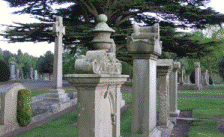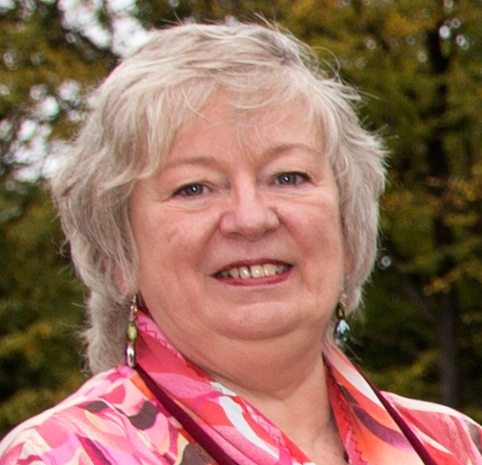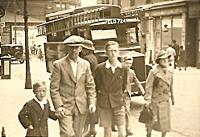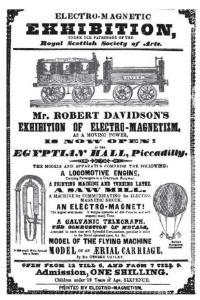- Birth*: Robert Davidson Nicolson was born on 2 February 1932 at Skipton, Yorkshire, England,
 ; Robert D Nicolson in the England & Wales, Birth
; Robert D Nicolson in the England & Wales, Birth
Index, 1916-2005
Name: Robert D Nicolson
Mother's Maiden Surname: Fairbank
Date of Registration: Jan-Feb-Mar 1932
Registration district: Skipton
Inferred County: Yorkshire
Volume Number: 9a
Page Number: 59.1,2 - He was the son of Robert Davidson Nicolson textile fitter and Kathleen Fairbank thread mill boxer.
- (Deceased) Death*: Robert Davidson Nicolson died circa 1998 at Grimsby, Lincolnshire, England,
 , Robert Davidson Nicolson in the England & Wales,
, Robert Davidson Nicolson in the England & Wales,
Death Index, 1916-2007
Name: Robert Davidson Nicolson
Birth Date: 2 Feb 1932
Date of Registration: Nov 1997
Age at Death: 65
Registration district: North east Lincolnshire
Inferred County: Lincolnshire
Register Number: C46C
District and Subdistrict: 5481C
Entry Number: 152.3,2 - (Witness) Photograph: He is in this photograph taken circa 1938 at Dundee, Angus, Scotland,
 , along with Robert Davidson Nicolson textile fitter, Samuel Forrester Nicolson merchant seaman.4
, along with Robert Davidson Nicolson textile fitter, Samuel Forrester Nicolson merchant seaman.4
- (Witness) Note for Web: Robert Davidson Nicolson and Robert Nicolson blacksmith, Robert Davidson Nicolson blacksmith, Robert Davidson Nicholson chief engineer, Robert Davidson Nicolson mechanical engineer, jute mill manager, Robert Davidson Nicholson, Robert Davidson Nicolson textile fitter and Robert Davidson Nicolson cinema manager was mentioned with Robert Davidson chemist. I have always wondered why so many of our Robert Nicolsons had/have the middle name of Davidson. I have looked far and wide to try to find a likely candidate marrying into our Nicolson clan, but have drawn a blank. That led me to think about someone who may have been known to the family from their days in Aberdeen. This Robert Davidson is only about 5 or 6 years younger than our Robert Nicolson who was the first (as far as we know) to use the Davidson name for his son born in 1823. Both men lived in the same part of Aberdeen - did they grow up together? Attend the same church? Did our Robert, as a blacksmith, cross paths with Robert Davidson the chemist who was building batteries, an electric locomotive, electric lathe, and electric printing press in the 1830s? Our Robert is in Dundee by 1836.
The Scientific Tourist: Aberdeen
Robert Davidson – pioneer electrician
Robert Davidson (1804-1894) was a man of eclectic interests, an inventor who had originality, vision and even prototype devices but did not have the financial or commercial resource to develop his ideas far enough to better the technology of the day.
His impact was not in generating a world-beating product or even gaining any significant personal wealth from his inventions but rather in providing an example to his successors of what could be done.
Davidson was born, schooled, spent much of his working life and died in Aberdeen. He attended the second and third year classes of Marischal College from 1819-1821, including the lecture course of Patrick Copland. Since in due course Davidson established himself as a manufacturer and supplier of chemicals, it is likely that he also
attended the optional chemistry class at the College given by William Henderson.
Davidson set himself up in business in the 1820s supplying yeast from premises at Causewayend and then in nearby Canal Road, close to the Aberdeen-Inverurie canal. Via a small, narrow, wooden slatted bridge (the ‘tarry briggie’), Canal Road today crosses the railway line that follows the old canal cutting. In Davidson’s younger days the area was edge-of-town market garden and nursery land that was gradually attracting houses and industry1. Davidson moved from yeast into chemical manufacturing and supplying, and diverse ventures such as file sharpening. He seems, though, to have had two passions: astronomy and electricity. In astronomy he built himself a large reflecting telescope of 35 feet length with a 2 foot diameter mirror that rivalled the largest productions of John Ramage. His telescope, with its big supporting structure of struts and ladders, must have been a landmark in the area for several years but no illustration of it has been found. What brings Robert Davidson into these notes is his electrical developments.
In the 1830’s, Faraday showed how to generate mechanical motion from electricity, albeit in a way that was useless for exploitation as a practical electric motor. Davidson became fascinated by the possibilities. He constructed his own batteries, not a difficult task for a chemical supplier and man with workshop skills, and by 1837 had made his first fair sized electric motor. In 1840 he held a public “Electromagnetic Exhibition” in Aberdeen and thousands paid 1/- entrance to see a working model electric locomotive able to carry two people, a model electric lathe, a small electric printing press and an electro-magnet that could lift 2 tons when supplied by a suitable battery.
The motor driving the lathe and printing press had a 5 foot diameter flywheel and the electromagnet had pole pieces 4 inches square. These were not desk-top toys. If Davidson had had this exhibition in 1880, many would have marvelled. This was 1840, truly well ‘ahead of his time’. The Aberdeen Banner prophesised that electromagnetic machinery “will in no distant date supplant steam”’. Davidson took his exhibition to Edinburgh in the following year, where the influential Robert Chambers of encyclopaedia fame made similar remarks and the young James Clerk Maxwell aged 10 was taken by his father to see it. In late 1842, Davidson took his exhibition to London in the hope of attracting sponsorship. By then he had added an electrically powered circular saw that cut 1” square planks in about 1 second and a powerful electric arc made by passing the current through two pieces of coke. He broke even in London but didn’t attract the sponsorship he’d hoped for. His motor was illustrated (above) in an edition of Penny’s Mechanic of 1843.
Between the Aberdeen and London exhibitions, Davidson built a full-sized prototype electric locomotive called Galvani. It was 16 feet long and weighed about 6 tons. In 1842 it ran at 4 miles per hour on the Glasgow to Edinburgh line (the railways hadn’t reached Aberdeen by then). Unfortunately, Galvani was destroyed before
Davidson could get it back, by men unknown but suspected of being promoters of steam engines. In truth, Davidson didn’t quite have the necessary technology to make a commercial success of electric railways. His power was provided by chemical batteries that were expensive to produce and to re-charge them the chemicals had to be
replaced. The re-chargeable lead-acid accumulator wasn’t invented until the end of the 1850s. He was some three decades before even the early days of viable electrical generators that could really make electric transport feasible. It all could have happened much earlier if Davidson had found a patron with deep pockets and patience but no-one was forthcoming in the early 1840s.
Electric locomotives would make city underground railways a possibility but they didn’t appear in Britain until around 1890. Robert Davidson was suddenly found to be still alive and was converted into a media celebrity “Octogenarian Aberdonian - oldest living electrician” e press trumpeted, or words to that effect. The Electrician magazine reported “Robert Davidson was undoubtedly the first to demonstrate the possibility of electrical traction in a practical way”. He was, but the torch he lit did not begin a blaze. Davidson died 4 years later at the age of 90, old enough to see his vision made real at last. Nothing remains in Canal Road of Davidson’s house at no. 32 or his business; only the name and the little road with its tarry briggie, itself a ‘modernisation’ of 1854 that replaced a lower bridge over the canal a little downstream. Davidson is buried in St Peter’s cemetery but his gravestone simply describes him as ‘chemist’.
John S. Reid
1 Diane Morgan “The Villages of Aberdeen: Round About Mounthooly”, Denburn Books, Aberdeen (1995),
outlines how the area has changed over the last two centuries and includes a short chapter on Davidson.
---------------
More info here https://www.scottishfield.co.uk/outdoors/motors/an-electric-future-planned-by-19th-century-scot/.6 - [S9] Website Ancestry.co.uk (www.ancestry.co.uk) England & Wales, Birth Index, 1916-2005 Source Information
Ancestry.com. England & Wales, Birth Index, 1916-2005 [database on-line]. Provo, UT, USA: Ancestry.com Operations
Inc, 2008.
Original data: General Register Office. England and Wales Civil Registration Indexes. London, England: General
Register Office.
© Crown copyright. Published by permission of the Controller of HMSO and the Office for National Statistics. You must
not copy on, transfer, or reproduce records without the prior permission of ONS. Indexes created by the General
Register Office, in London, England.
Description
This database is a searchable, digitized version of the indices of civil registrations in England and Wales, reported
quarterly to the General Register Office (GRO) in London. This index spans the years between 1916 and 2005. You need
the information found in an original index to request a copy of a birth certificate for the individual referenced. Learn
more... [Aug 2015] - [S9] Website Ancestry.co.uk (www.ancestry.co.uk) England & Wales,
Death Index, 1916-2007
Source Information
Ancestry.com. England & Wales, Death Index, 1916-2007 [database on-line]. Provo, UT, USA: Ancestry.com Operations
Inc, 2007.
Original data: General Register Office. England and Wales Civil Registration Indexes. London, England: General
Register Office. © Crown copyright. Published by permission of the Controller of HMSO and the Office for National
Statistics. You must not copy on, transfer or reproduce records without the prior permission of ONS. Indexes created by
the General Register Office, in London, England.
Description
This database is a searchable, digitized version of the indices of civil registrations in England and Wales, reported
quarterly to the General Register Office (GRO) in London. This index spans the years between 1916 between 2005. You
need the information found in an original index to request a copy of a death certificate for the individual referenced.
Learn more... [Aug 2015] - [S40] RN [Dec 2009].
- [S40] CO via email [May 2018].
- CO via email [May 2018]
- [S49] Website Web Site online (www.) https://homepages.abdn.ac.uk/npmuseum/Scitour/Davidson.pdf
Robert Davidson Nicolson
M, #5087, b. 2 February 1932, d. circa 1998
Last Edited: 14 Sep 2023
Parents:
Father*: Robert Davidson Nicolson textile fitter b. 15 Jan 1893, d. 13 Feb 1951
Mother*: Kathleen Fairbank thread mill boxer b. 1895
Mother*: Kathleen Fairbank thread mill boxer b. 1895
Relationship:
2nd cousin 1 time removed of Patricia Catherine Adamson
Notes
Citations
Charts:
Clark, Helen c 1769 descendants
Croyl, George c 1700 descendants
Geddes, Janet c1745 descendants
Grant, John c1745 descendants
Henderson, Andrew c1768 descendants
Hume, John c1735 descendants
Kinloch, Thomas c1703 descendants
McLeish, James c1735 descendants
Nicolson, John c1765 descendants
Spense, Margaret c1703 descendants
Tait, Andrew s1670 descendants
Worrel, John c1765 descendants
Croyl, George c 1700 descendants
Geddes, Janet c1745 descendants
Grant, John c1745 descendants
Henderson, Andrew c1768 descendants
Hume, John c1735 descendants
Kinloch, Thomas c1703 descendants
McLeish, James c1735 descendants
Nicolson, John c1765 descendants
Spense, Margaret c1703 descendants
Tait, Andrew s1670 descendants
Worrel, John c1765 descendants
 Genes on the Web
Genes on the Web

